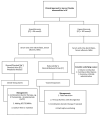The Role of Chloride in Cardiorenal Syndrome: A Practical Review
- PMID: 40806852
- PMCID: PMC12347930
- DOI: 10.3390/jcm14155230
The Role of Chloride in Cardiorenal Syndrome: A Practical Review
Abstract
Chloride, long considered a passive extracellular anion, has emerged as a key determinant in the pathophysiology and management of heart failure (HF) and cardiorenal syndrome. In contrast to sodium, which primarily reflects water balance and vasopressin activity, chloride exerts broader effects on neurohormonal activation, acid-base regulation, renal tubular function, and diuretic responsiveness. Its interaction with With-no-Lysine (WNK) kinases and chloride-sensitive transporters underscores its pivotal role in electrolyte and volume homeostasis. Hypochloremia, frequently observed in HF patients treated with loop diuretics, is independently associated with adverse outcomes, diuretic resistance, and arrhythmic risk. Conversely, hyperchloremia-often iatrogenic-may contribute to renal vasoconstriction and hyperchloremic metabolic acidosis. Experimental data also implicate chloride dysregulation in myocardial electrical disturbances and an increased risk of sudden cardiac death. Despite mounting evidence of its clinical importance, serum chloride remains underappreciated in contemporary risk assessment models and treatment algorithms. This review synthesizes emerging evidence on chloride's role in HF, explores its diagnostic and therapeutic implications, and advocates for its integration into individualized care strategies. Future studies should aim to prospectively validate these associations, evaluate chloride-guided therapeutic interventions, and assess whether incorporating chloride into prognostic models can improve risk stratification and outcomes in patients with heart failure and cardiorenal syndrome.
Keywords: cardiorenal syndrome; chloride; diuretic resistance; heart failure; hyperchloremia; hypochloremia; neurohormonal activation.
Conflict of interest statement
The authors declare no conflict of interest.
Figures


Similar articles
-
Prescription of Controlled Substances: Benefits and Risks.2025 Jul 6. In: StatPearls [Internet]. Treasure Island (FL): StatPearls Publishing; 2025 Jan–. 2025 Jul 6. In: StatPearls [Internet]. Treasure Island (FL): StatPearls Publishing; 2025 Jan–. PMID: 30726003 Free Books & Documents.
-
Management of urinary stones by experts in stone disease (ESD 2025).Arch Ital Urol Androl. 2025 Jun 30;97(2):14085. doi: 10.4081/aiua.2025.14085. Epub 2025 Jun 30. Arch Ital Urol Androl. 2025. PMID: 40583613 Review.
-
Continuous infusion versus bolus injection of loop diuretics for acute heart failure.Cochrane Database Syst Rev. 2024 May 22;5(5):CD014811. doi: 10.1002/14651858.CD014811.pub2. Cochrane Database Syst Rev. 2024. PMID: 38775253 Free PMC article.
-
[Volume and health outcomes: evidence from systematic reviews and from evaluation of Italian hospital data].Epidemiol Prev. 2013 Mar-Jun;37(2-3 Suppl 2):1-100. Epidemiol Prev. 2013. PMID: 23851286 Italian.
-
Diabetic Ketoacidosis Fluid Therapy Algorithm in the Golden Hours: Iatrogenic Hyperchloremic Acidosis Instead of Unmeasured Anion Acidosis.J Clin Med. 2025 Jun 11;14(12):4125. doi: 10.3390/jcm14124125. J Clin Med. 2025. PMID: 40565871 Free PMC article.
References
-
- Rangaswami J., Bhalla V., Blair J.E.A., Chang T.I., Costa S., Lentine K.L., Lerma E.V., Mezue K., Molitch M., Mullens W., et al. Cardiorenal Syndrome: Classification, Pathophysiology, Diagnosis, and Treatment Strategies: A Scientific Statement from the American Heart Association. Circulation. 2019;139:e840–e878. doi: 10.1161/CIR.0000000000000664. - DOI - PubMed
-
- Mitsas A.C., Elzawawi M., Mavrogeni S., Boekels M., Khan A., Eldawy M., Stamatakis I., Kouris D., Daboul B., Gunkel O., et al. Heart Failure and Cardiorenal Syndrome: A Narrative Review on Pathophysiology, Diagnostic and Therapeutic Regimens—From a Cardiologist’s View. J. Clin. Med. 2022;11:7041. doi: 10.3390/jcm11237041. - DOI - PMC - PubMed
Publication types
LinkOut - more resources
Full Text Sources
Research Materials
Miscellaneous

